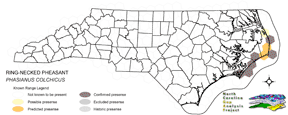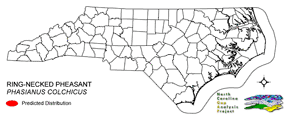
| Taxa: |
| Order: |
| Family: |
| Aves |
| Galliformes |
| Phasianidae |
| NatureServe Global Rank: |
| NatureServe State (NC) Rank: |
| G5 |
| SE |
| Federal Status: |
| NC State Status: |
| --- |
| --- |


| Land Unit |
| US Fish & Wildlife Service |
| US Forest Service |
| US National Park Service |
| US Department of Defense |
| NC State Parks |
| NC University System |
| NC Wildlife Res. Com. |
| NC Forest Service |
| NC Div. of Coastal Mgmt. |
| Local Governments |
| Non-Governmental Org. |
| Other Public Lands |
| Private Lands |
| GAP Status 1-2 |
| All Protected Lands |
| Statewide |
| Hectares |
| 271.08 |
| 0.00 |
| 0.00 |
| 3,599.64 |
| 33.39 |
| 0.00 |
| 8.01 |
| 0.00 |
| 2.07 |
| 0.00 |
| 5.04 |
| 0.09 |
| 1,450.53 |
| 1,844.46 |
| 3,919.32 |
| 5,369.85 |
| Acres |
| 669.85 |
| 0.00 |
| 0.00 |
| 8,894.90 |
| 82.51 |
| 0.00 |
| 19.79 |
| 0.00 |
| 5.12 |
| 0.00 |
| 12.45 |
| 0.22 |
| 3,584.34 |
| 4,557.76 |
| 9,684.85 |
| 13,269.19 |
| % of Dist. on |
| Prot. Lands |
| 6.9 % |
| 0.0 % |
| 0.0 % |
| 91.8 % |
| 0.9 % |
| 0.0 % |
| 0.2 % |
| 0.0 % |
| < 0.1 % |
| 0.1 % |
| 0.1 % |
| < 0.1 % |
| 0.0 % |
| 47.1 % |
| ----- |
| ----- |
| % of Dist. on |
| All Lands |
| 5.0 % |
| 0.0 % |
| 0.0 % |
| 67.0 % |
| 0.6 % |
| 0.0 % |
| 0.1 % |
| 0.0 % |
| < 0.1 % |
| 0.0 % |
| < 0.1 % |
| < 0.1 % |
| 27.0 % |
| 34.3 % |
| ----- |
| ----- |
|
Very local at specific sites on the barrier islands since 1930s (Fussell 1994, Potter et al. 1980). Inhabits any type of semi-open area, such as the edge of marshes and forests, grassy or brushy fields, farms with mixed crops, or hedgerows. The presence of water may be an important factor (Kaufman 1996); rarely found far from it (Harrison 1975). Nests on the ground in open areas with herbaceous ground cover to conceal nest (Harrison 1975). Forages on the ground (Ehrlich et al. 1988). NATURE SERVE GLOBAL HABITAT COMMENTS: Open country (especially cultivated areas, scrubby wastes, open woodland and edges of woods), grassy steppe, desert oases, riverside thickets, swamps and open mountain forest (AOU 1983). Winter shelter includes bushes and trees along streams, shelterbelts, and fencerows. Usually nests in fields, brushy edges, or pastures, also along road rights-of-way. Nest is shallow depression scratched out by female. |
| Code | Name | Description | NC Natural Heritage Program Equivalent |
| 371 | Maritime Grasslands | Dune grass community consisting of sea oats and beach grasses. | Dune grass, Maritime dry grassland |
| 20 | Coniferous Regeneration | Regenerating pine stands. Predominantly loblolly pine, but slash and longleaf stands occur as well. | No equivalent |
| 36 | Successional Deciduous Forests | Regenerating deciduous trees with a shrub stature. Commonly dominated by sweetgum, tulip poplars and maples. | No equivalent |
| 180 | Agricultural Crop Fields | Farm fields used for row crops. | No equivalent |
| 205 | Agricultural Pasture/Hay and Natural Herbaceous | Farm fields used for pasture grass or hay production, as well as old fields dominated by native and exotic grasses. | No equivalent |
| 202 | Residential Urban | Includes vegetation interspersed in residential areas. Includes lawns, mixed species woodlots, and horticultural shrubs. Vegetation accounts for between 20 - 70% of the cover. | No equivalent |
|
McAtee, W.L. 1945. The ring-necked pheasant and its management in North America. Wash. 320 pp.
Fussell, J.O. III. 1994. A birderís guide to coastal North Carolina. Chapel Hill and London: The University of North Carolina Press. Kaufman K. 1996. Lives of North American Birds. Boston, New York: Houghton Mifflin Company. Pough, R. H. 1957. Audubon Western Bird Guide. Doubleday. 316 pp. Harrison, H.H. 1975. A field guide to bird's nests in the U.S. east of the Mississippi River. Houghton Mifflin Company, Boston, Massachusetts. 257 p. Harrison, C. 1978. A field guide to the nests, eggs and nestlings of North American birds. Collins, Cleveland, Ohio. Howman, K. C. R. 1979. Pheasants, their breeding and management. 117 pp. Potter, E. F., J. F. Parnell, and R. P. Teulings. 1980. Birds of the Carolinas. Univ. North Carolina Press, Chapel Hill. 408 pp. Terres, J.K. 1980. The Audubon Society encyclopedia of North American birds. Alfred A. Knopf, New York. American Ornithologists' Union (AOU), Committee on Classification and Nomenclature. 1983. Check-list of North American Birds. Sixth Edition. American Ornithologists' Union, Allen Press, Inc., Lawrence, Kansas. Ehrlich, P.R., D.S. Dobkin, and D. Wheye. 1988. The birder's handbook:a field guide to the natural history of North American birds. Simon and Shuster, Inc., New York. xxx + 785 pp. Reichel, J. D., and P. O. Glass. 1991. Checklist of the birds of the Mariana Islands. Elepaio 50:3-11. |
For more information please contact them at:
NC-GAP Analysis Project
Dept. of Zoology, NCSU
Campus Box 7617
Raleigh, NC 27695-7617
(919) 513-2853
www.basic.ncsu.edu/ncgap